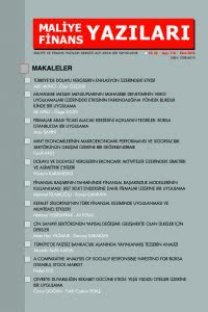Kurumsal İmaj’ın Firma ve Müşteriler Üzerindeki Etkileri
Kurumsal İmaj, Kurumsal Ün, Müşteri Davranışları
The Effects of Corporate Image on Customers’ Behaviour Kemal ÇEK
Corporate Image, Corporate Reputation, Customer Relations,
___
- Aaker, D. A. (1996) ‘Measuring brand equity across products and markets.’ California Management Review, Vol.38, No. 3, Pg. 102-20. Aaker, David A. and Keller, Kevin Lane (1990), “Consumer Evaluations of Brand Extensions”, Journal of Marketing,54,(January),pp.27-41 . Abd-El-Salam, E. M., Shawky, A. Y., El-Nahas, T. (2013) ‘The impact of corporate image and reputation on service quality, customer satisfaction and customer loyalty: testing the mediating role. Case analysis in an international service company’ The Business & Management Review, Vol.3 Number-2, January 2013. Ailawadi, K., Lehmann, D., and Neslin, S. (2003), “Revenue Premium as an Outcome Measure of Brand Equity,” Journal of Marketing, Vol. 67, No. 4, 1-17. Andreassen, T. W., Lindestad, B., (1998) “Customer loyalty and complex services: The impact of corporate image on quality, customer satisfaction and loyalty for customers with varying degrees of service expertise”, International Journal of Service Industry Management, Vol. 9 Iss: 1, pp.7 – 23. Brace, I., (2008), Questionnaire Design: How to Plan, Structure and Write Survey Material for Effective Market Research (2ndEd.), Kogan Page: Philadelphia. Creswell, J. W., and Plano Clark, V. L., (2007), Designing and Conducting Mixed Methods Research, Sage Publications: California. Doney, P.M, & Cannon, J.P. (1997). An Examination of the nature of trust in buyer-seller relationships. Journal of Marketing, 61, 2, 35-51. Easterby-Smith, M., Thorpe, R. and Jackson, P. (2008) Management Research, 3rd Ed., UK, Sage Publications Ltd. Fombrun, C.J. (1996) `Reputation: Realizing Value from the Corporate Image’, Cambridge, MA: Harvard Business School Press. Fombrun, C. J. & Van Riel, C. (1998), The Reputational Landscape, in: Corporate Reputation Review, Vol. 1, pp. 5–14. http://reputationinstitute.com/ frames/crr/V01/Fombrun_Landscape.pdf Gaines-Ross, L. (1997) ‘Leveraging corporate equity’, paper presented at the Conference on Corporate Reputation, Image and Competitiveness, New York University. Grönroos, C. (1984). “A Service Quality Model and Its Marketing Implications.” European Journal of Marketing 18(4): 36-44. Gummesson, E. (1993). Quality Management in Service Organizations: An Interpretation of the Service Quality Phenomenon and a Synthesis of International Research, Interantional Service Quality Association.
- ISSN: 1308-6014
- Yayın Aralığı: Yılda 2 Sayı
- Başlangıç: 2008
- Yayıncı: Maliye ve Finans Yazıları Yayıncılık Ltd. Şti.
Kamu Harcamalarının Türkiye’de Bazı Makro Ekonomik Değişkenler Üzerine Etkisi
Osman Cenk Kanca, Metin Bayrak
Halka Açık Mevduat Bankalarında Tahvil İhracının Net Faiz Getirisine Etkisi
Aşırı Büyüme Seviyelerinde Hissedar Değeri Yaratmak: Türkiye Örneği
Levent ATAÜNAL, Ali Osman GÜRBÜZ
Petrol Fiyatlarındaki Değişimlerin Türkiye’nin Cari İşlemler Açığına Etkileri
Selim GÜNGÖR, Lütfiye SÖNMEZ, Özge KORKMAZ, Süleyman Serdar KARACA
Kurumsal İmaj’ın Firma ve Müşteriler Üzerindeki Etkileri
